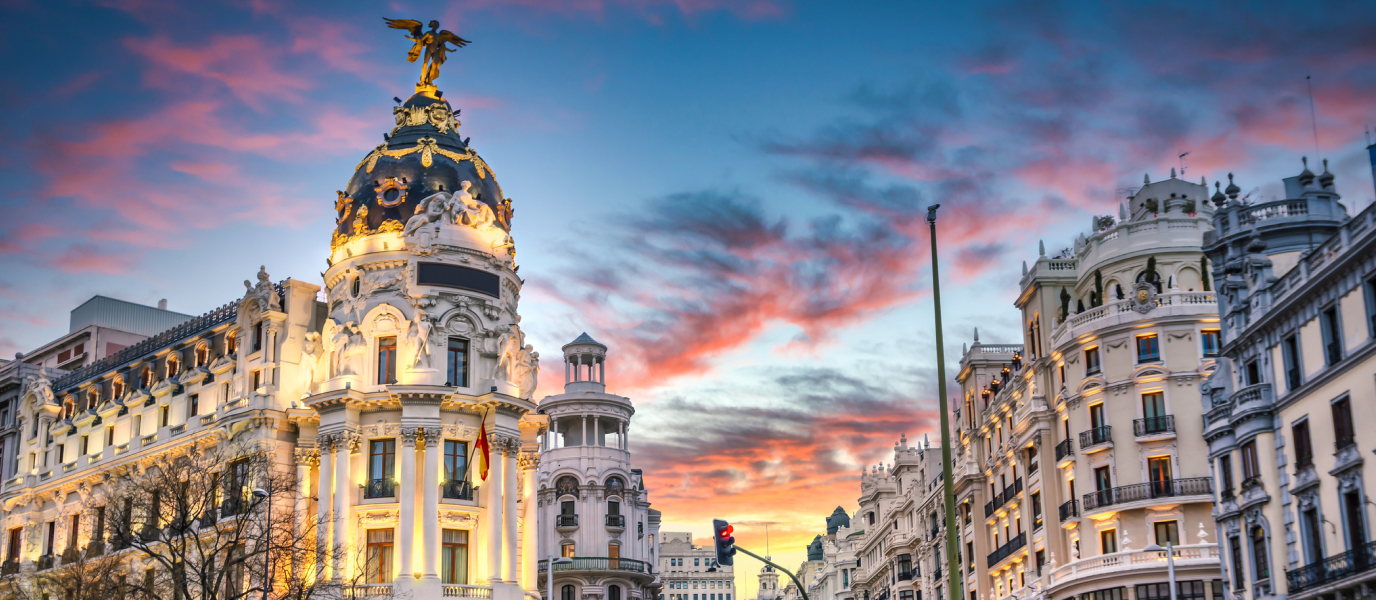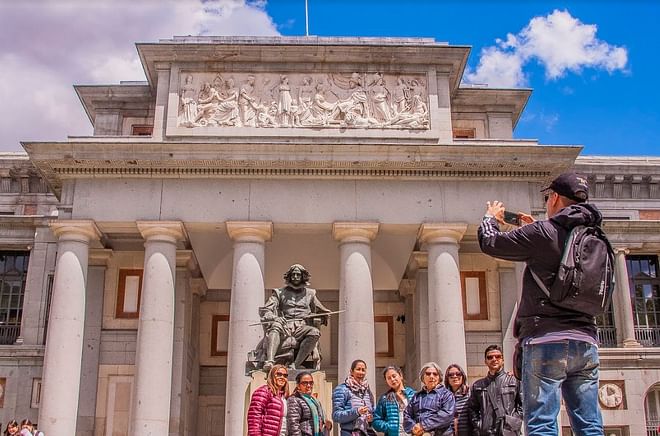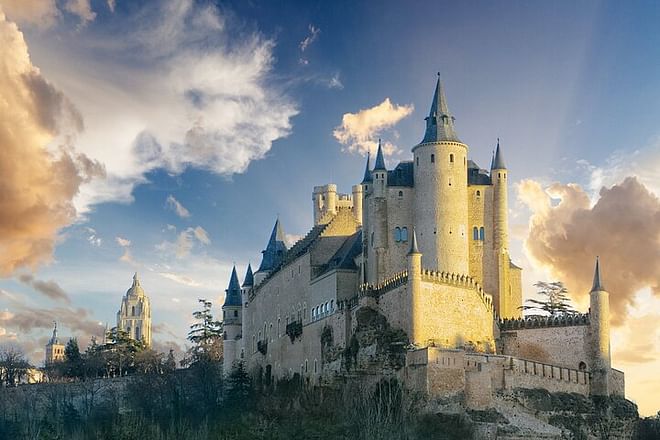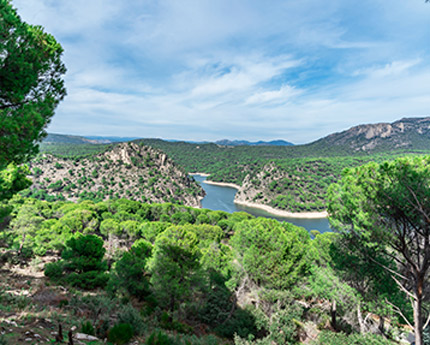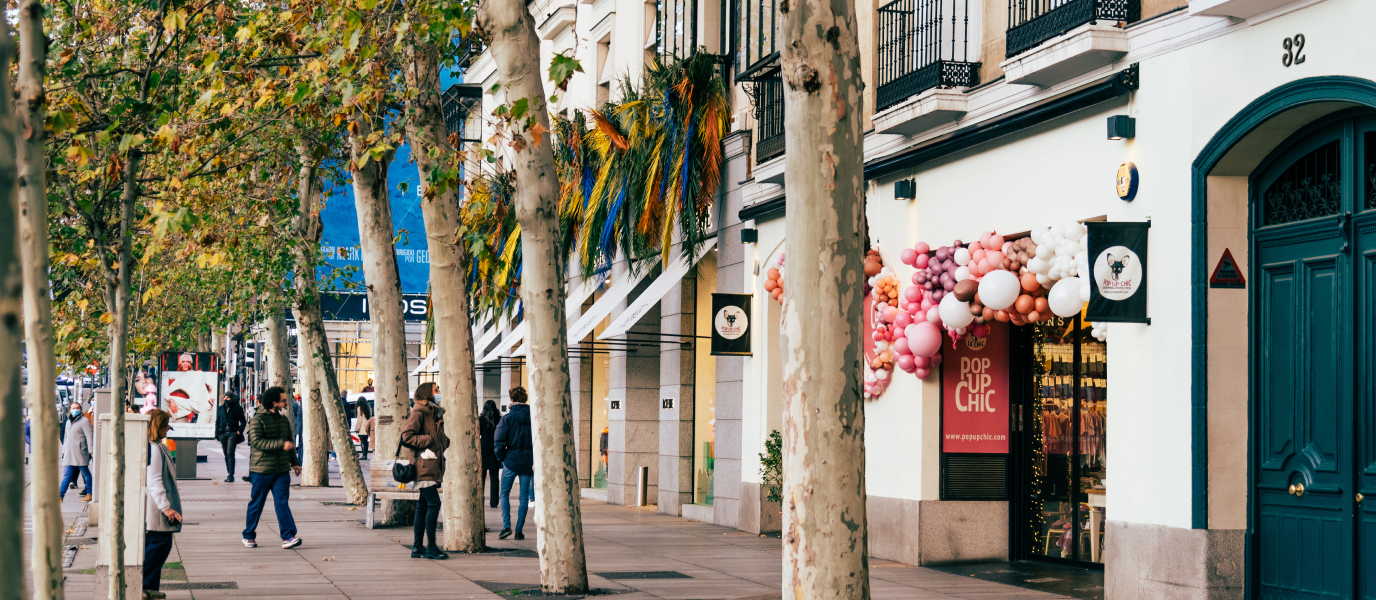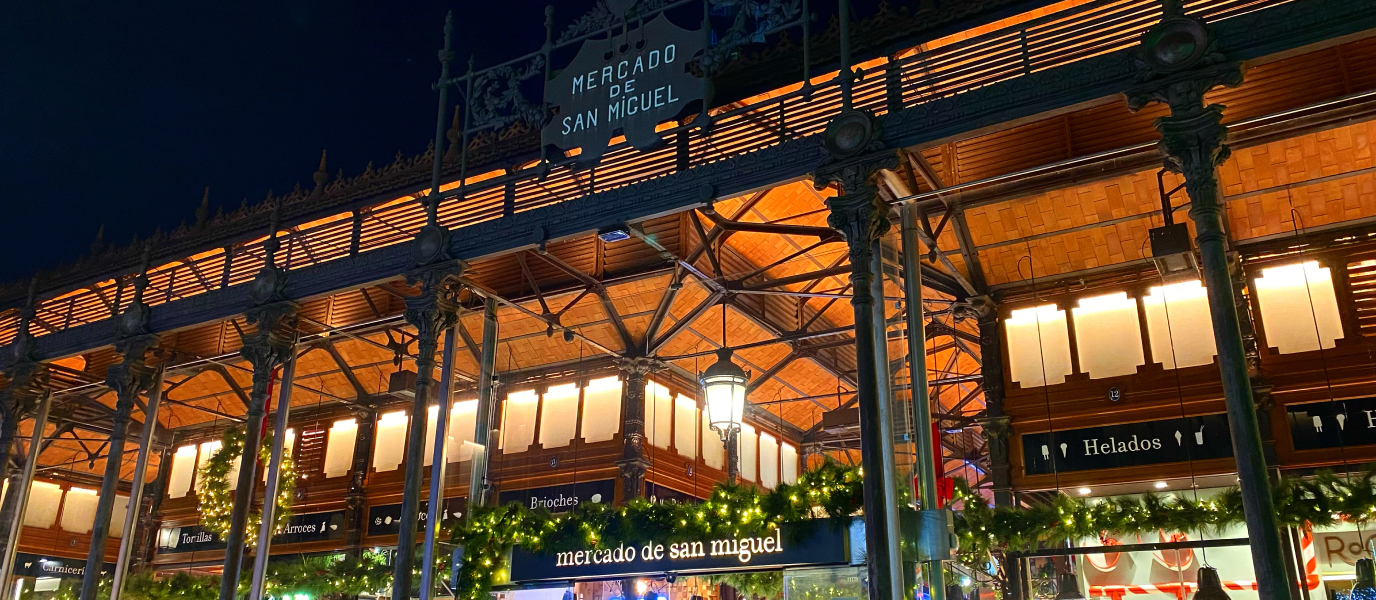Open, welcoming, beautiful, fun… Madrid is, along with Barcelona, Seville, and Valencia, one of the most visited Spanish cities by Spanish and foreign tourists alike. Its monumental and natural heritage, its cuisine, its transport, and its leisure facilities are all fantastic. It’s an ideal city to visit with your family, with friends or on your own. Madrid always welcomes visitors with open arms.
Thanks to this article, you’ll be able to get to know Madrid in detail through our recommendations. We invite you to take a wonderful trip that will allow you to enjoy the most important activities and tourist attractions in the city.
We bring you a complete list to allow you to get to know the best and most significant areas and neighbourhoods, museums, parks, gardens or gastronomic spots of Madrid, essential to discover and soak up all its essence on your one-day, two-day, three-day or weekend trip to Madrid.
Are you coming with us? Don’t miss anything on your visit to Madrid!
1. THE 12 ESSENTIAL THINGS TO DO IN MADRID
Related experiences
Museo del Prado
This is Spain’s leading art gallery and some regard it as the best in the world. The Museo del Prado, which is home to some 8,000 works by the greatest artists in the history of art, occupies two magnificent buildings. The Juan de Villanueva building and the Casón del Buen Retiro. Don’t miss the rooms dedicated to Velázquez and Goya. Paseo del Prado, no number.
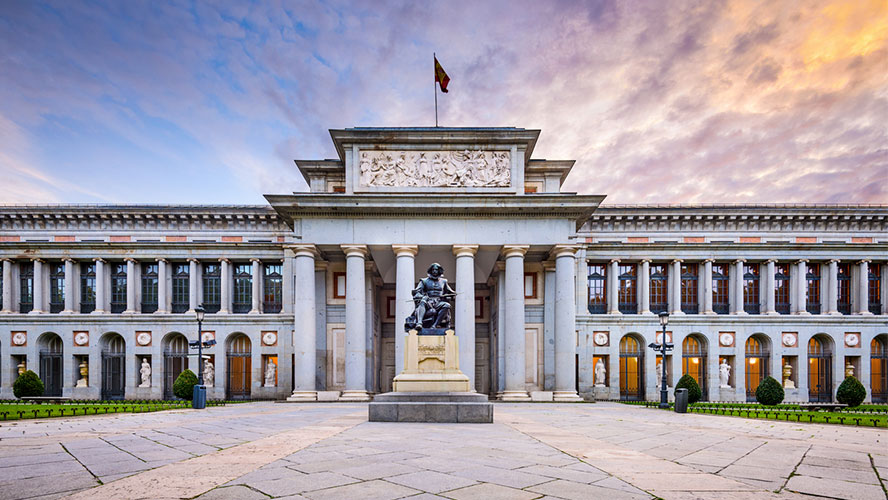
Retiro Park
This is one of the great lungs of the city and one of the most beautiful natural spaces in Madrid. On Sundays, the avenues of Retiro Park are filled with street musicians, families on bicycle rides, and puppet theatres, among other things. Its pond, presided over by the monument to Alfonso XII, is ideal for a peaceful outing in a rowing boat. Next to the pond are the Palacio de Velázquez and the Palacio de Cristal, dedicated to art exhibitions.
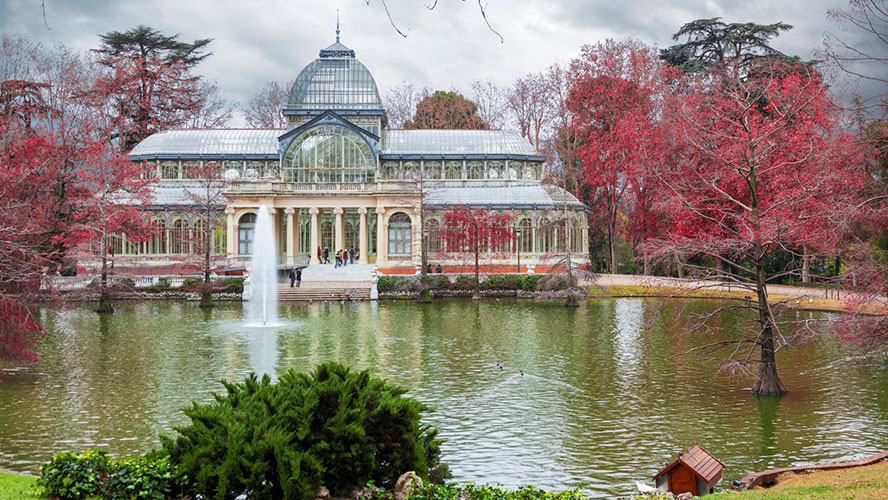
Puerta del Sol
It’s the geographical and sentimental heart of Madrid, the starting point from which all national roads are measured. The semi-circular Puerta del Sol is probably the liveliest and most vibrant place in the city. Its most iconic building, the old Casa de Correos, has the famous clock that chimes on New Year’s Eve.
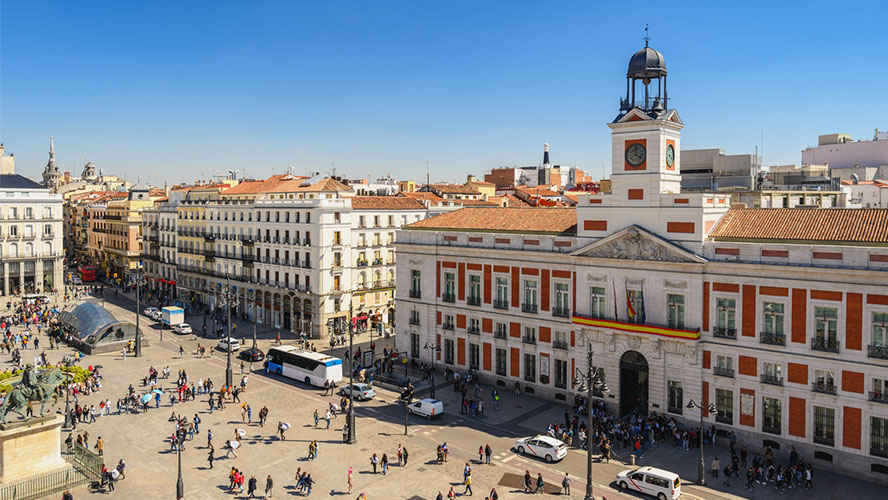
Gran Vía
Gran Vía, inaugurated in 1910, marked the arrival of modern city planning to Madrid. It’s the street where the great theatres, cinemas, restaurants, hotels, and fashionable shops are to be found. It starts at Calle de Alcalá and ends at Plaza de España. It’s lined with unique buildings such as the Telefónica building, Madrid’s first skyscraper, and the Capitol building.
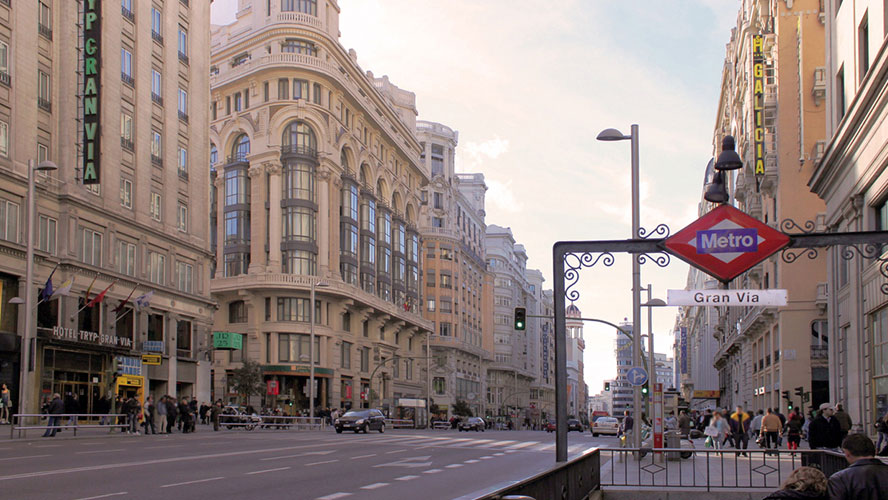
Madrid’s Plaza Mayor
Opened in 1620 to be used for official events, popular festivals, and bullfights, as well as for properties, the Plaza Mayor is one of the liveliest places in the heart of Madrid. In its centre is the equestrian statue of Felipe III. Its two most outstanding buildings are the Casa de la Panadería, with its Salón Real, and the Casa de la Carnicería.
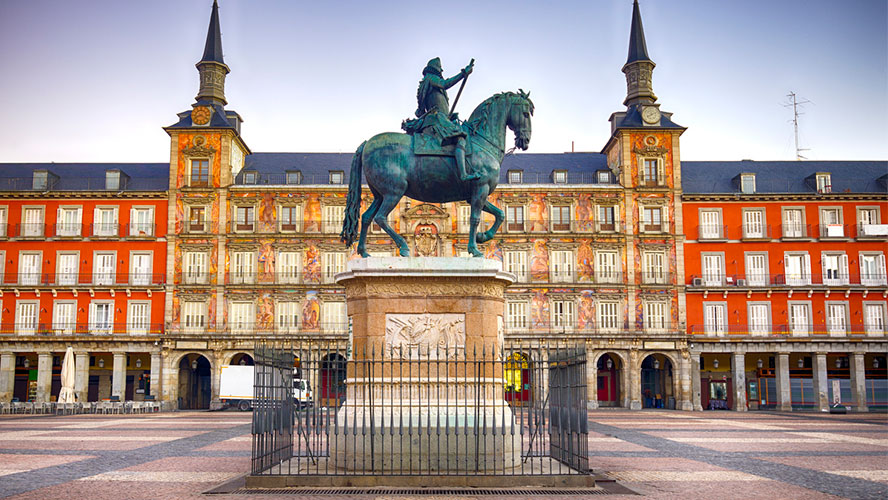
Royal Palace of Madrid
Built with granite and white stone, the Royal Palace of Madrid is the most important building linked to the Spanish monarchy. Its spectacular marble main staircase is the work of Sabatini, the ceilings of the Salón de Guardias and the Salón del Trono were painted by Tiepolo and the vaults of the gala dining room feature paintings by Mengs, González Velázquez, and Bayeu. Be sure to visit the Royal Armoury, the Royal Carriage Museum, and the 2.66-hectare Sabatini Gardens. Calle Bailén, no number
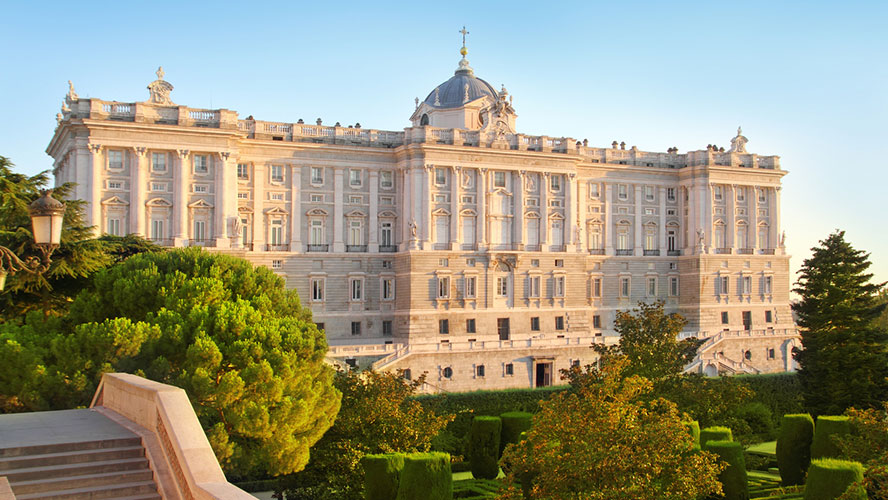
Estadio Santiago Bernabéu
The Santiago Bernabéu Stadium, home of Real Madrid Football Club, was inaugurated in 1941, although it has undergone subsequent renovations, with the last one taking place in 1993 to add circular towers at the corners to serve as access ramps. It can hold 81,000 spectators. If you’re interested in seeing it, buy a ticket for the Real Madrid Museum and take the Bernabéu Tour, and you’ll get to know the ins and outs of the stadium and the club’s successful history. Avenida Concha Espina, 1
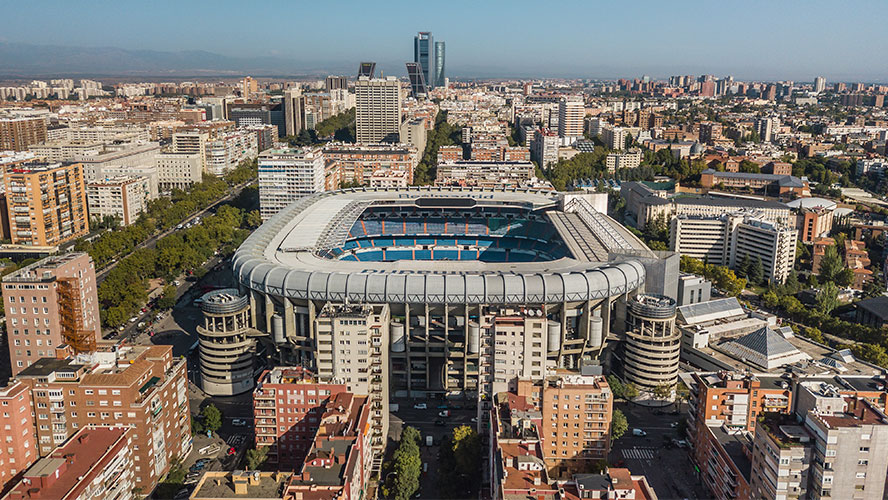
Temple of Debod
This is a piece of Egypt in Madrid. The Temple of Debod, dating from the 2nd century BC, was a gift from the Egyptian government to Spain for its collaboration in saving the temples of Nubia. It was opened to the public in Madrid in 1972 and since then has been one of the most visited monuments in the capital.
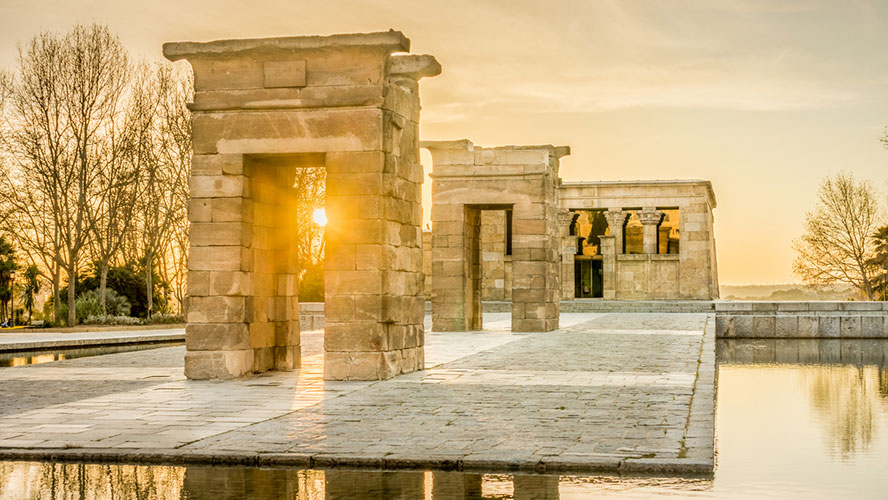
Almudena Cathedral
Built on the site of a former mosque, the Almudena Cathedral is practically next to the Royal Palace. Its cathedral, between the end of the 19th century and the end of the 20th century, was consecrated in 1993 by Pope John Paul II during one of his trips to Spain. It’s dedicated to the Virgin of Almudena, patron saint of Madrid. King Felipe VI and Queen Letizia Ortiz were married here in 2004. Calle Bailén, 10
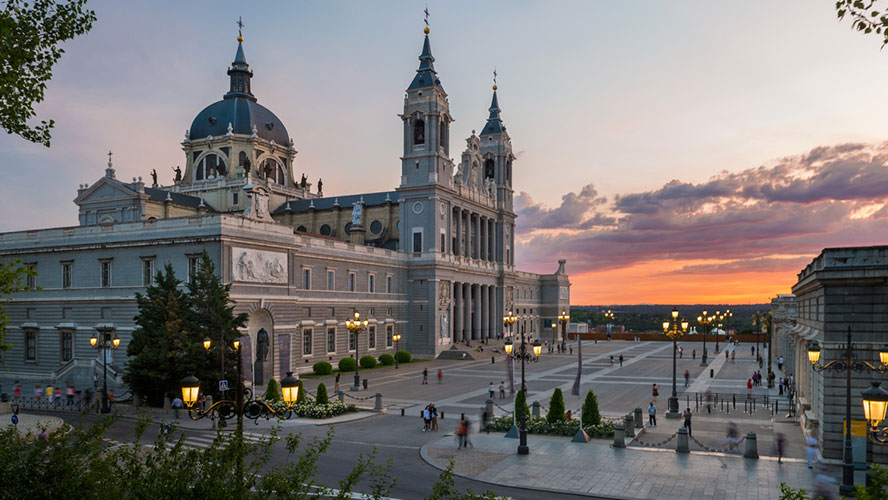
Puerta de Alcalá
Located a stone’s throw from the Plaza de Cibeles and next to Retiro Park, the Puerta de Alcalá is one of the five royal gates that provided access to the city and is one of the biggest icons of Madrid. It was built by Sabatini between 1769 and 1778, with granite and white stone, commissioned by Carlos III. It has served as inspiration for the Arc de Triomphe in Paris and the Brandenburg Gate in Berlin. Plaza de la Independencia.
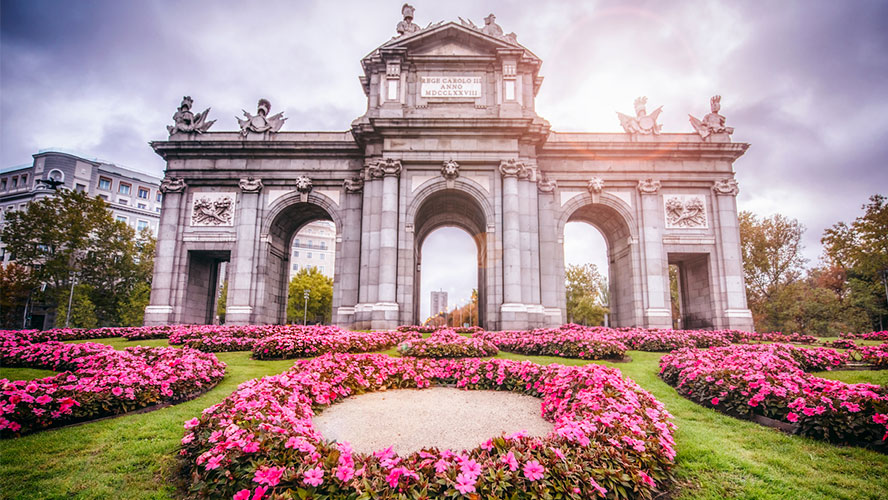
Las Ventas Bullring
With a capacity for 23,798 people, the Las Ventas bullring is the largest in Spain and the third largest in the world, after the ones in Mexico City and Valencia (Venezuela). It has been declared a “site of cultural interest within the historic-artistic monument category”. Bullfighting fans feel at home here. Calle Alcalá, 237
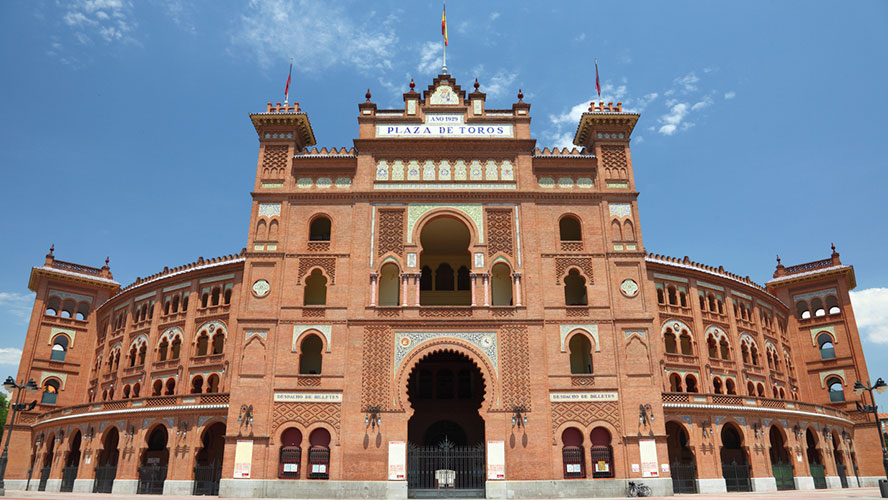
2. MUSEUMS IN MADRID
In addition to The Prado Museum, the art gallery you can’t miss on your trip to Madrid, there are other important museums to visit, such as the Thyssen-Bornemisza, the Reina Sofía, and the one dedicated to the Valencian painter Joaquín Sorolla.
Thyssen-Bornemisza Museum
This is one of the great art museums in Madrid. The Thyssen Museum is located in the Palace of Villahermosa and, although its collection is privately owned, it has belonged to all Spaniards since 1993. It’s an essential companion to the Reina Sofía Museum, with paintings by Manet, Renoir, Cézanne, Van Gogh, Gauguin, and Hopper, among others. In addition, since 2004, part of the Carmen Thyssen-Bornemisza collection, featuring over 200 works, has been housed here. Paseo del Prado, 8
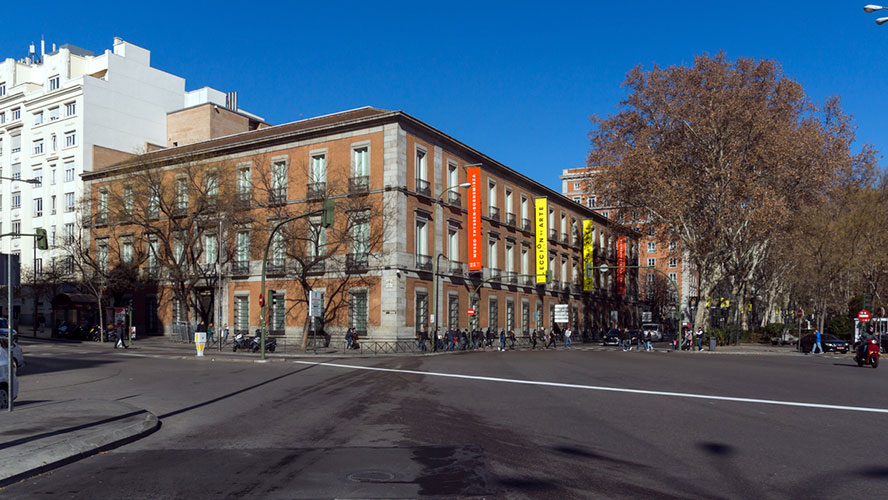
The Reina Sofía Museum
It occupies the site of the former Hospital de San Carlos, a building by Sabatini which was later extended by the French architect Jean Nouvel. The Reina Sofía Museum is home to the great works of early avant-garde and 20th century and contemporary art. Don’t forget to look for Picasso’s “Guernica” and for works by iconic artists such as Dalí, Miró, Julio González, and Chillida. Calle de Santa Isabel, 58.
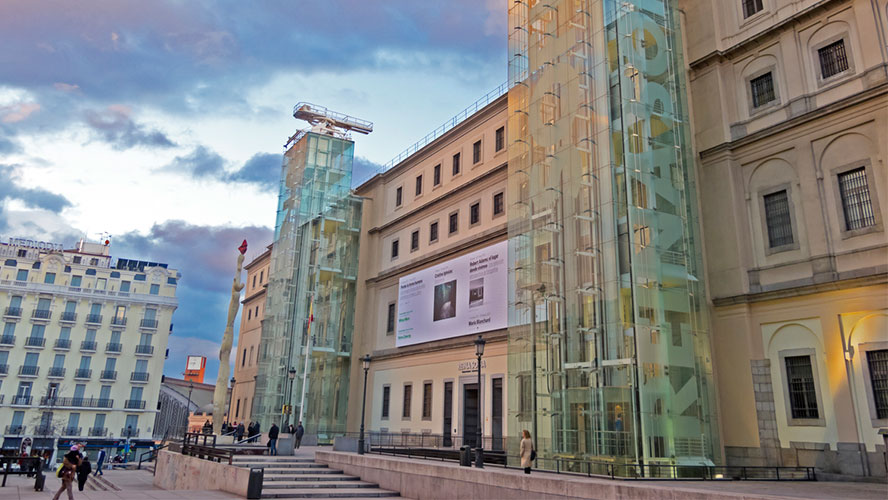
Sorolla Museum
We have the generosity of the family of the Valencian painter to thank for the Sorolla Museum, which is located in the artist’s former Madrid residence. The artist’s widow donated the property as it was during the painter’s lifetime, a residence with a beautiful garden designed by Sorolla himself in which there’s a marble fountain and a pergola where the family used to sit. The visit continues through the painter’s studio and workshop, where his personal belongings are kept. Of course, here you can see some of the essential works of this artist, who painted so much of the Mediterranean. Paseo del General Martínez Campos, 37.
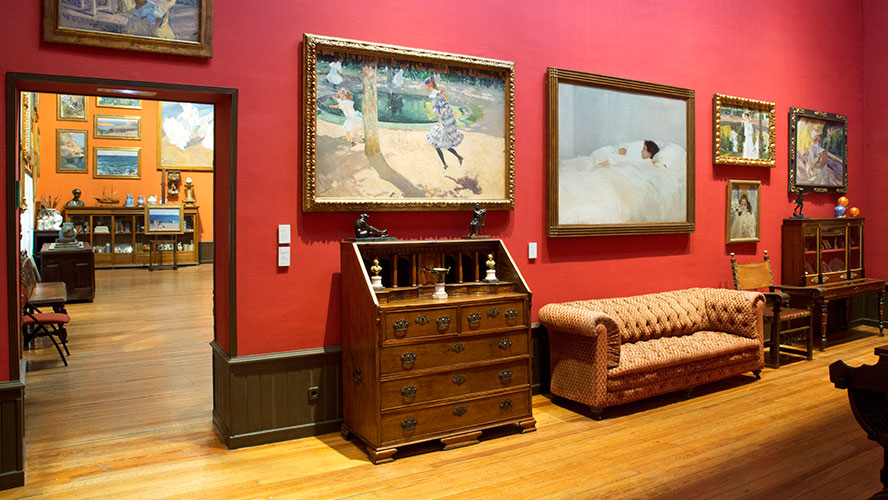
3. PARKS AND GARDENS
In addition to Retiro Park, the great green lung of the centre of Madrid, there are other natural spaces that are well worth a visit, such as Casa de Campo, the Sabatini Gardens, the Campo del Moro, Madrid Río, Capricho park at Alameda de Osuna or the very old Botanical Gardens.
Casa de Campo
Along with Retiro Park, it’s the great green lung of Madrid. Casa de Campo has no less than 1,535 hectares of land, making it the largest public park in the city. Within its grounds are the Amusement Park, the Casa de Campo Lake, the Zoo, the Cable Car, the Madrid Arena multi-purpose pavilion, the Venta del Batán, etc.
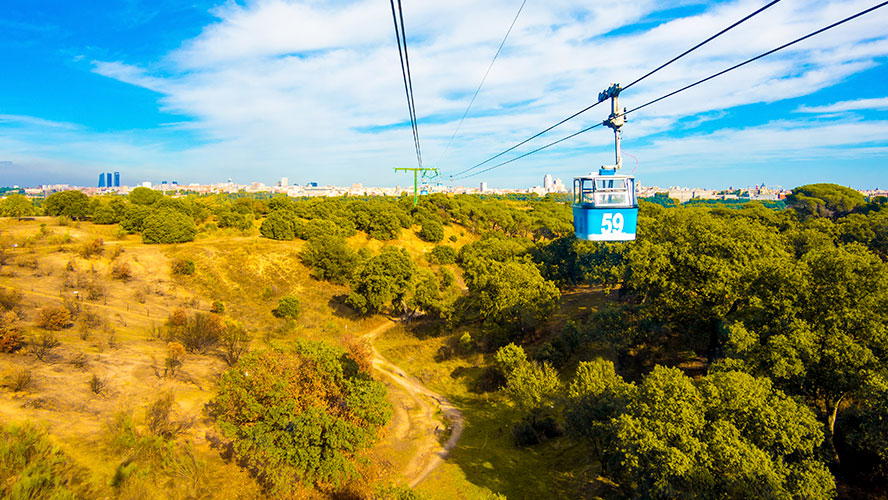
Jardines de Sabatini
Located next to the Royal Palace and very close to the Temple of Debod and the Almudena Cathedral, this unique green space in the historic centre of Madrid wasn’t designed by Sabatini, as you might expect, but by Fernando García Mercadal, who was subsequently consigned to history. The romantic Sabatini Gardens are on the site of the former Royal Stables and have a formal neoclassical style, with geometric hedges. Its pond is a particular highlight, which has three fountains and is surrounded by effigies of Spanish kings. From here you can enjoy unforgettable sunsets on clear days. Bailén, 2.
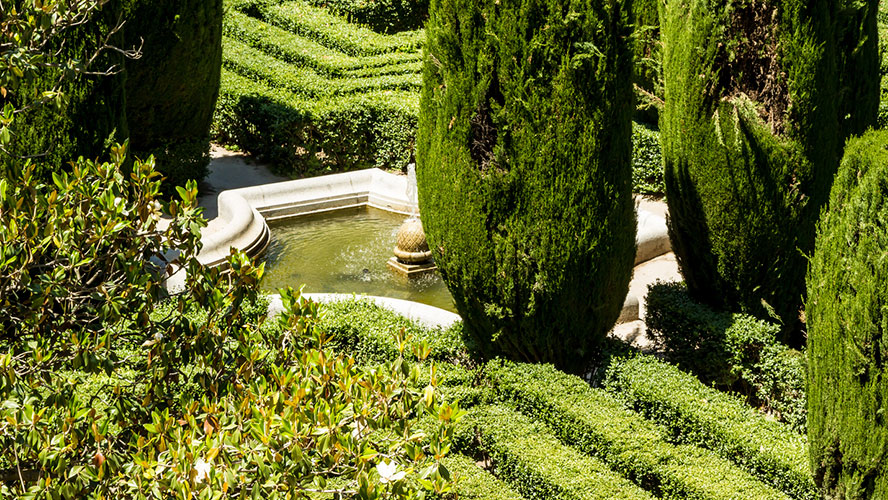
Campo del Moro
Covering an area of 20 hectares, this is one of the three landscaped areas that adorn the surroundings of the Royal Palace, along with the Sabatini Gardens, and the Plaza de Oriente. Commissioned by Queen María Cristina in the 19th century, Campo del Moro is a beautiful English-style garden. Its two large monumental fountains stand out: the Fountain of the Tritons and the Fountain of the Shells, with the latter having been designed by Ventura Rodríguez. Paseo de la Virgen del Puerto, no number
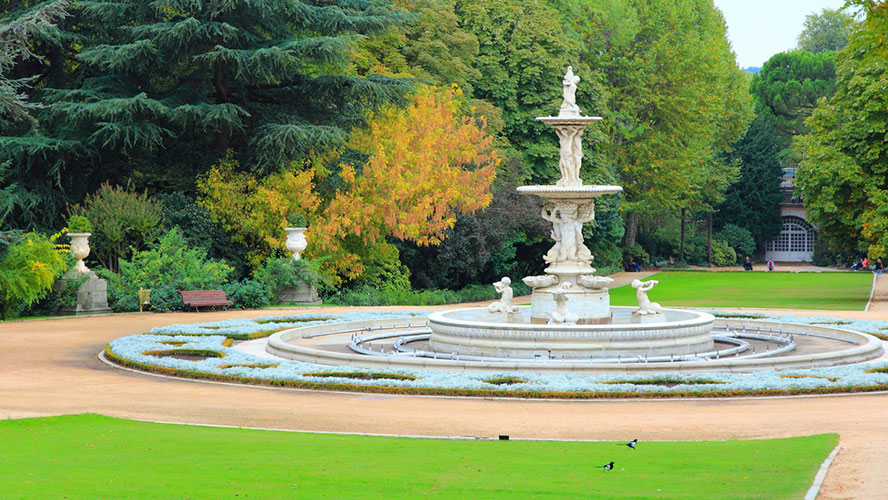
Madrid Río
Parallel to the Manzanares River, Madrid Río is a great space for nature, leisure and recreation, from which you can see the Royal Palace and the Almudena Cathedral. There are 17 children’s play areas, with swings made from environmentally friendly materials. If you get the chance, visit Madrid Río Beach, with its fun water jets.
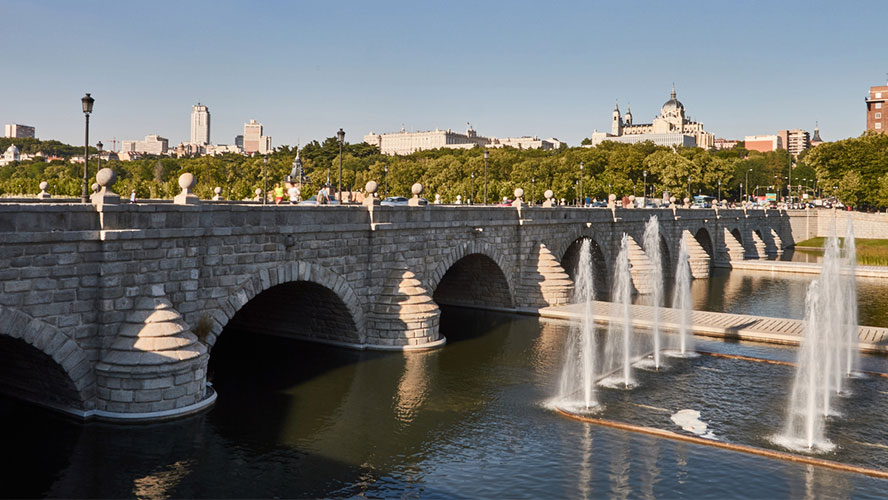
Capricho Park at Alameda de Osuna
Capricho Park at Alameda de Osuna is one of the most beautiful parks in Madrid. It was created in 1784 by the Dukes of Osuna, a unique married couple who were passionate about culture and supported artists, bullfighters, and intellectuals. The park contains small temples, chapels, fountains, small squares, and even a palace, the one occupied by the dukes during their life in Madrid. The garden has three different styles: the French parterre, with its trimmed hedges, the English garden, which evokes nature in its purest state, and the Italian giardino, the oldest space on the estate, where hedges are mixed with trees.
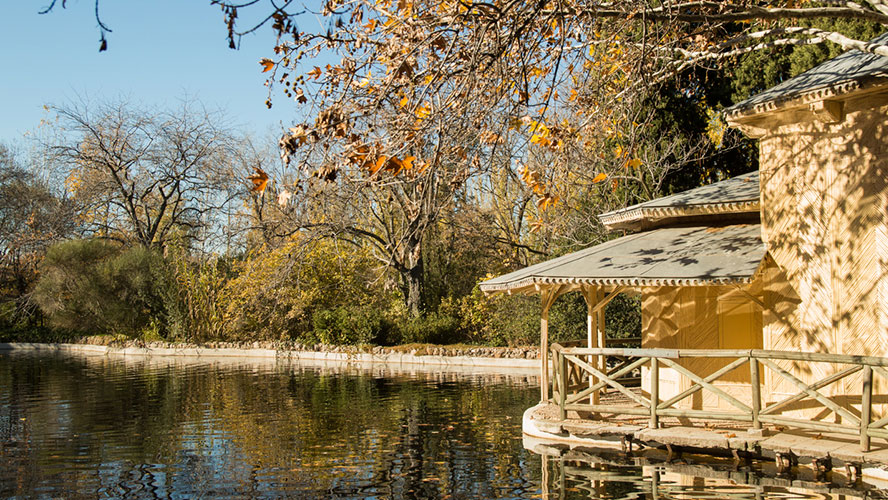
Madrid’s Botanical Garden
Located in a prime spot in Madrid, next to the Paseo del Prado and the Atocha roundabout, the Botanical Garden is a large peaceful and natural space with a long history that began in 1755. It has over 30,000 species of exotic plants and trees from all over the world and is managed by the Spanish National Research Council (CSIC). Plaza de Murillo, 2
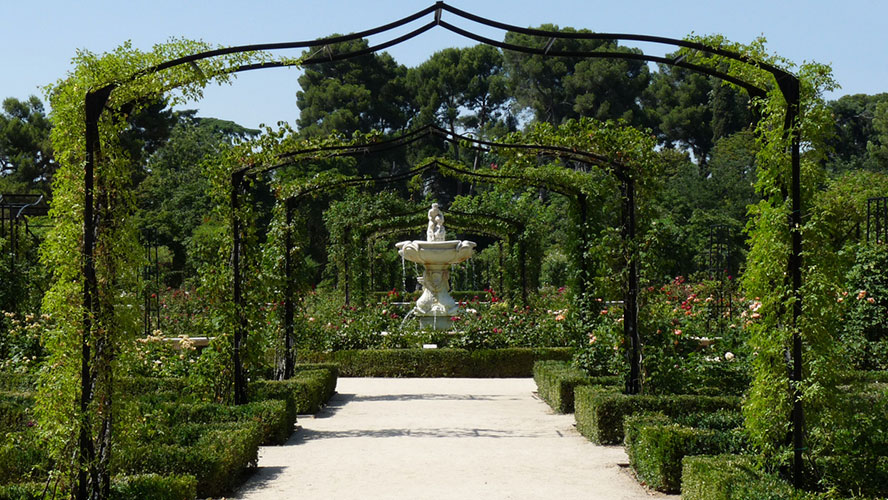
4. A STROLL THROUGH MADRID’S NEIGHBOURHOODS
Sol-Gran Vía
The area around Puerta del Sol and Gran Vía is where you can best hear the heartbeat of Madrid. It’s the heart of the city and around this central neighbourhood you’ll find the most traditional shops, large monumental buildings, the most unique theatres and cinemas, the iconic Plaza Mayor and Calle de Alcalá, among others. It’s impossible to visit Madrid and not enjoy this iconic place, because it’s here that you can feel the pulse of the capital like nowhere else.
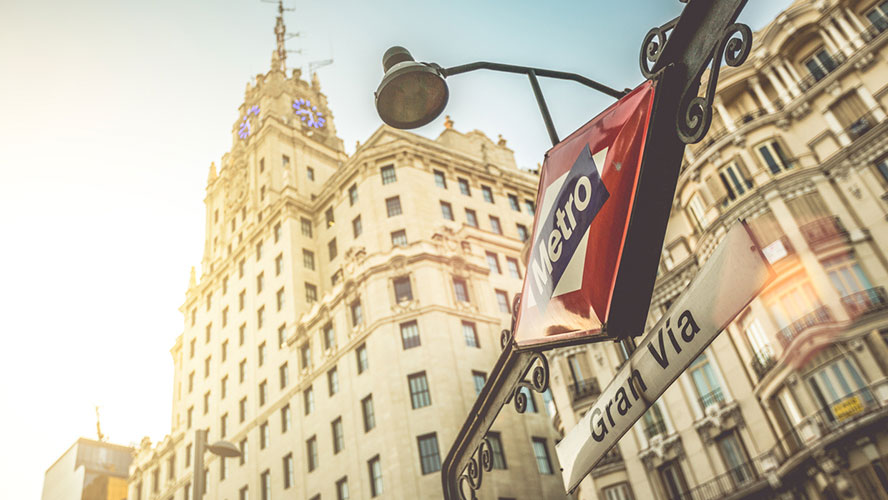
La Latina
Along with the neighbouring Lavapiés, this is probably the oldest and most traditional neighbourhood in Madrid. Known as the Madrid of Los Austrias, La Latina has a medieval layout of narrow streets and large squares, which today is lined with shops, bars, terraces, and music and theatre venues. Its most unique areas? La Cava Alta and La Cava Baja, Puerta de Toledo, Mercado de la Cebada, Plaza de la Paja, Puerta Cerrada, the Vistillas gardens, etc. On Sundays, the neighbourhood turns into the Rastro (a famous street market).
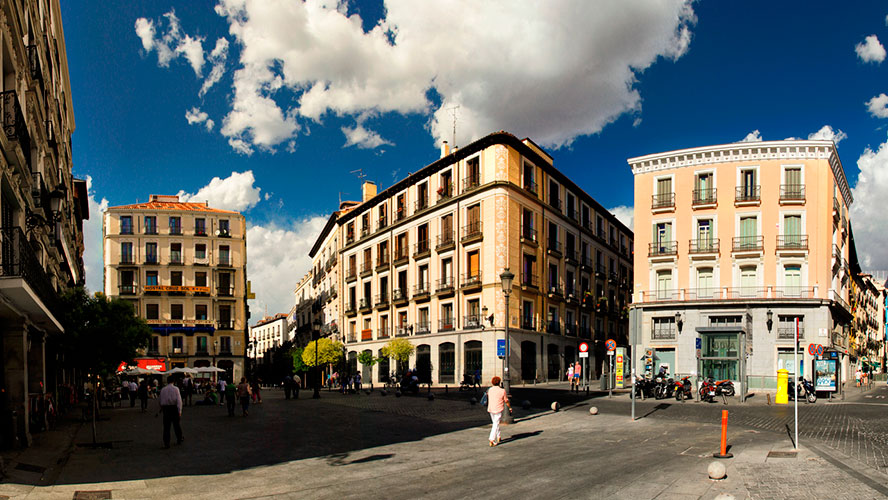
Las Letras neighbourhood
It owes its name to the great writers of the Golden Age who lived in and walked its streets. The Las Letras neighbourhood is located between Paseo del Prado and Plaza de Santa Ana, in an area that’s almost traffic-free, with an abundance of small shops and restaurants. Here you’ll find the Lope de Vega House Museum and the church of San Sebastián, where Cervantes is buried.
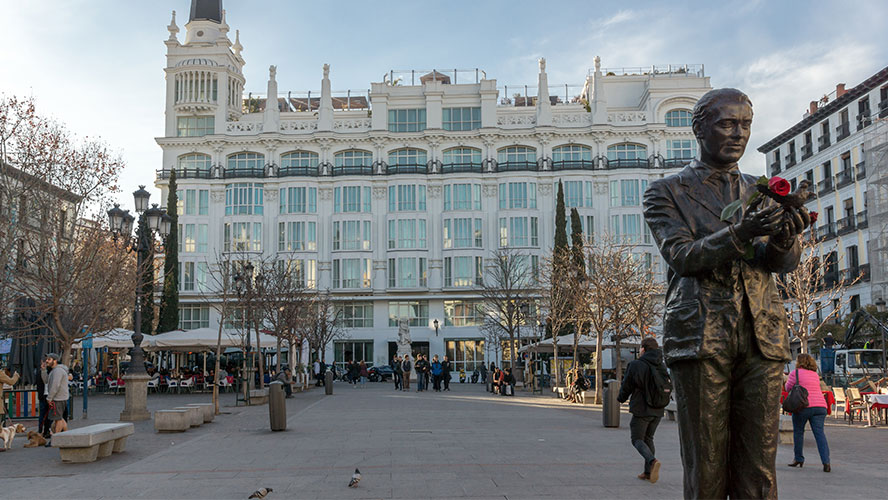
Salamanca Neighbourhood
Known as “the Golden Mile”, the neighbourhood of Salamanca is a great example of class, glamour, and elegance. The finest shops in the capital are to be found here, especially in the streets of José Ortega y Gasset, Goya, and Serrano. It’s also home to the National Archaeological Museum, the Lázaro Galdiano Museum, and the Juan March Foundation. It’s also an ideal neighbourhood to enjoy its fantastic restaurants and gastronomic markets.

Chueca
This is one of Madrid’s trendiest neighbourhoods. In Chueca, you’ll find unique and fair trade shops, cultural institutions, small art galleries, good restaurants and, above all, fun and bars. It’s always lively, especially at night. It’s the epicentre of Madrid Pride, which takes place at the beginning of July.

Chamberí
Chamberí is the most traditional and elegant neighbourhood in Madrid. It’s a quiet area that saw the rise of some of Madrid’s aristocracy and bourgeoisie in the 19th and 20th centuries. Today its streets are home to old modernist mansions, many of them occupied by embassies, boutique hotels, theatres, and cutting-edge restaurants. Not to be forgotten is Calle de Ponzano, one of Madrid’s great gastronomic streets. The district also offers a wide range of cultural activities: Sorolla Museum, Teatros del Canal, cines Verdi, etc.
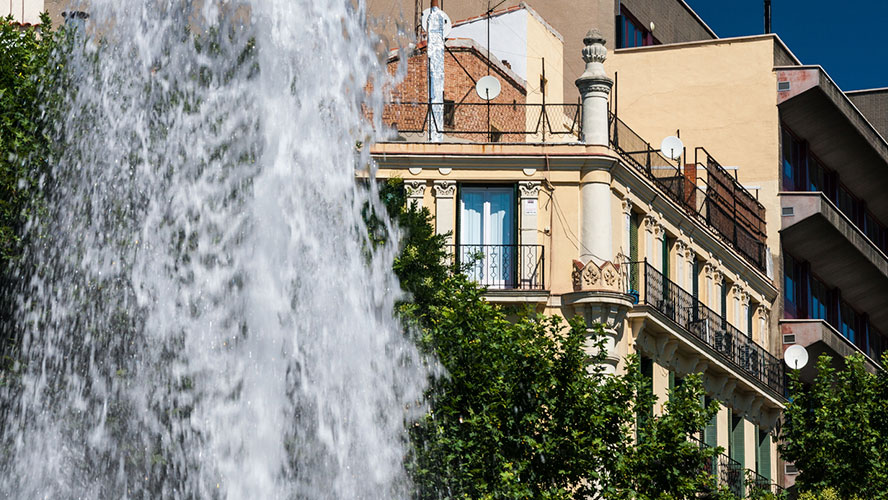
Malasaña
This is the nightlife and party district par excellence. Malasaña neighbourhood has a wide range of shops, bookshops, various types of restaurants, street markets, museums and, above all, many bars where you can go out and party in Madrid. Some of the bars that were the hallmarks of the mythical movida madrileña are still around today. The neighbourhood is bordered by the streets of Fuencarral, Carranza, Alberto Aguilera, Princesa, and Gran Vía.
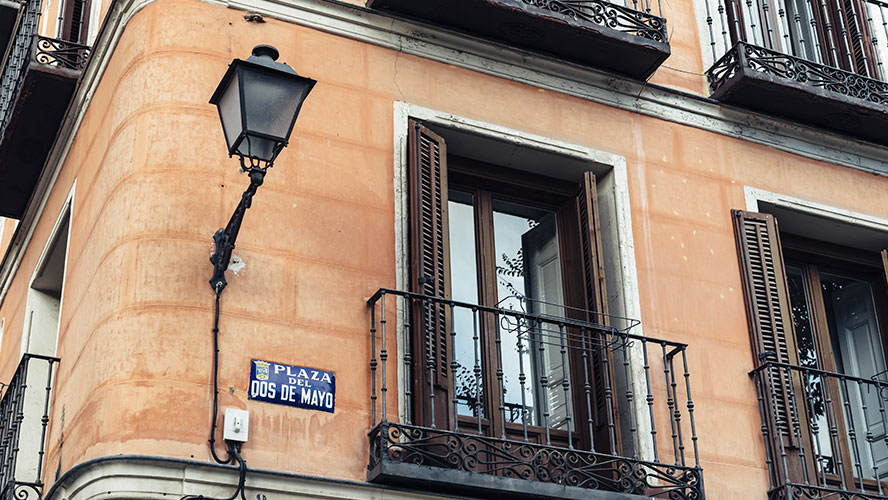
Lavapiés neighbourhood
This is Madrid’s alternative and multicultural neighbourhood. In Lavapiés, you’ll find a mixture of traditional and international shopping and gastronomic offerings. You can have churros or torreznos (pork scratchings) in a traditional bar or tandoori chicken in an Indian restaurant. It has two large and lively cultural centres: La Casa Encendida and Tabacalera.
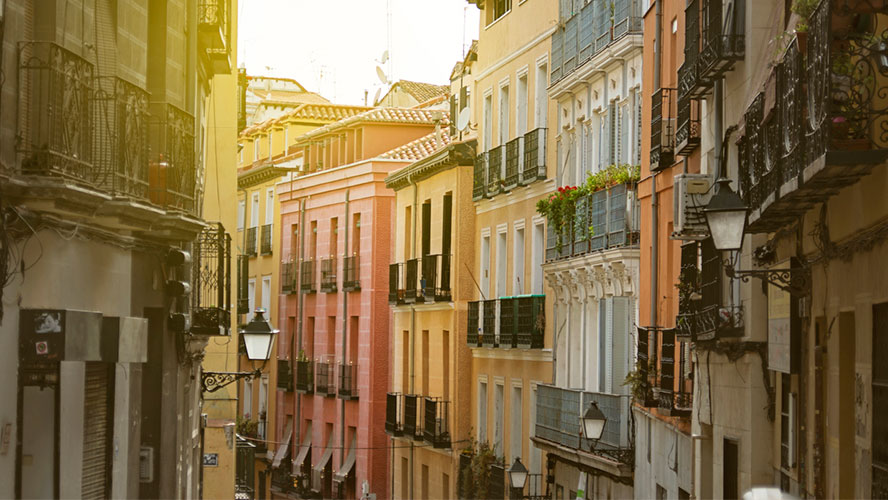
5. SQUARES IN MADRID
In addition to Plaza Mayor and Puerta del Sol, Madrid has an endless number of unique squares, many of them as iconic as Plaza de España, Plaza Cibeles, Plaza Colón, Plaza Oriente, Plaza Santa Ana, and Plaza Callao.
Plaza de España
A symbol of post-war Madrid, Plaza de España is famous for two unique buildings: the Torre de Madrid and the Edificio España, both designed by the architects and brothers Otamendi in the 1940s and 1950s. In the centre of the square is the monument to Miguel de Cervantes, erected in 1916 to commemorate the third centenary of the death of the illustrious author of Don Quixote.
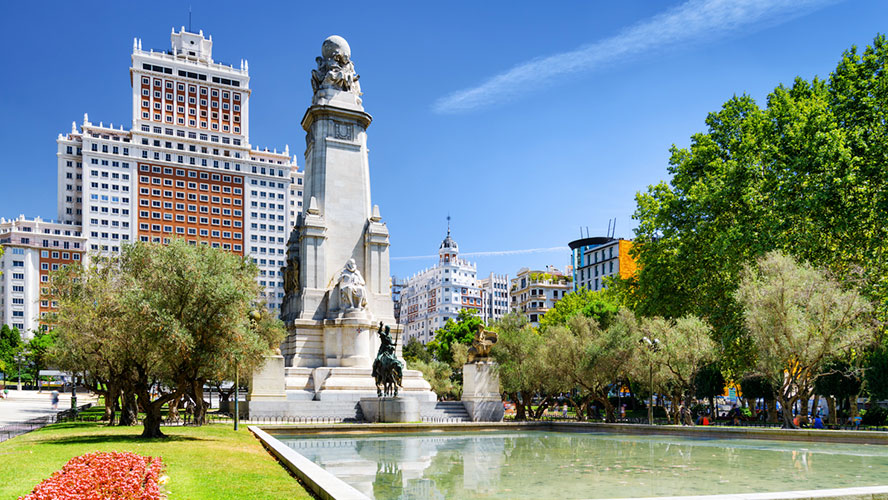
Cibeles
It’s located in the heart of the city, at the intersection of calle de Alcalá and Paseo de Recoletos. In the centre of the Plaza de Cibeles is the famous Cibeles fountain, which was designed in 1782 by Ventura Rodríguez, one of Madrid’s great architects. The square is bordered by the Buenavista Palace or Army Headquarters (1777), the Linares Palace or Casa de América, the Bank of Spain, and the Palace of Communications, which today is the seat of Madrid City Council.
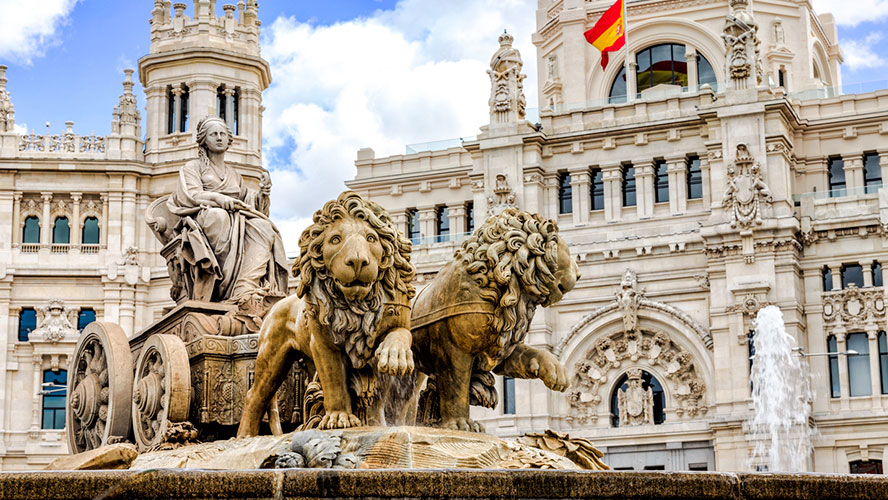
Colón
Presided over by the statue of the discoverer of America, the Plaza de Colón connects and links two of the capital’s main streets: Paseo de la Castellana and Paseo de Recoletos. Here you’ll find Platea, one of Madrid’s great dining venues, the Torres de Colón, and the Jardines del Descubrimiento. You can’t miss it, because in this square there’s a colossal Spanish flag. And it looks great.
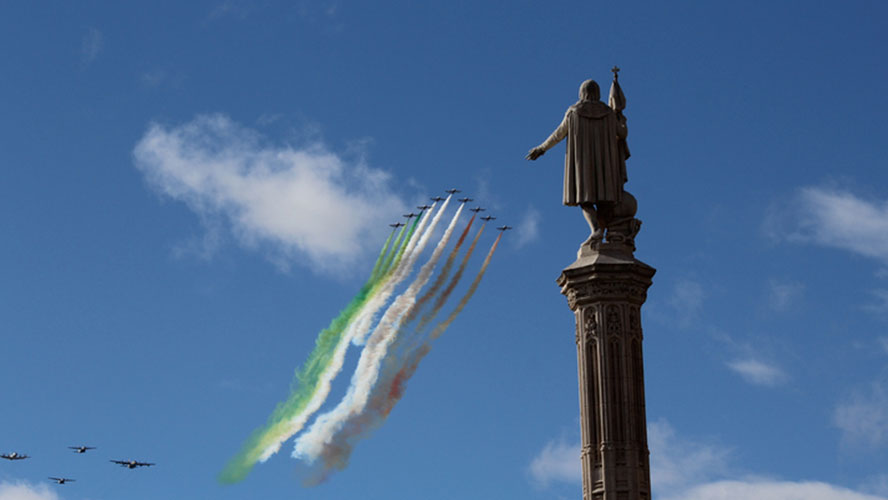
Plaza de Oriente
This is the space between the Royal Palace and Teatro Real in Madrid. The Plaza de Oriente has a lot of charm. It’s a lovely pedestrianised square and its 20 limestone statues, representing Spanish monarchs, give it a monumental feel. The square was designed in 1844 during the reign of Isabel II and has an artistic fountain presided over by a statue of Felipe IV on horseback.
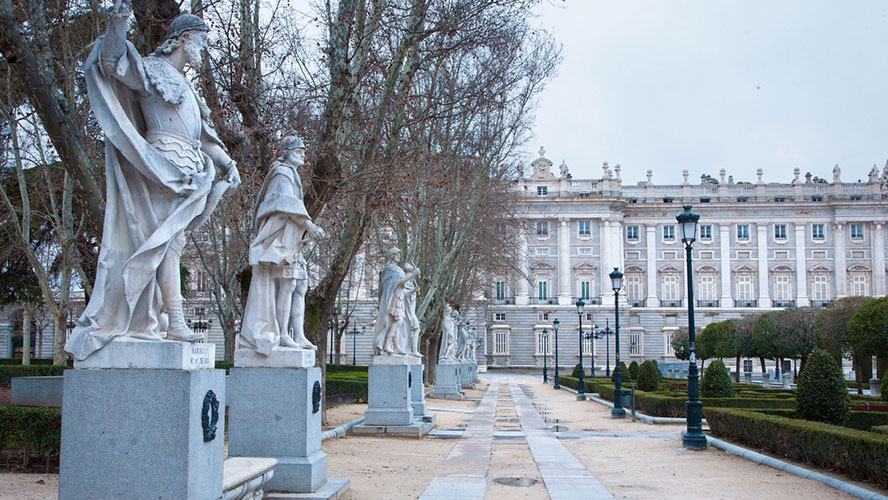
Santa Ana
Located in the so-called Barrio de las Letras, the Plaza de Santa Ana is the perfect place to relax and enjoy its lively atmosphere and its wide range of restaurants and bars. In this square you’ll find the Teatro Español, which occupies the place that centuries ago was the site of one of Madrid’s first comedy playhouses: the Corral del Príncipe. There are two iconic statues in the square: those of the poet Federico García Lorca and the Golden Age playwright Calderón de la Barca.
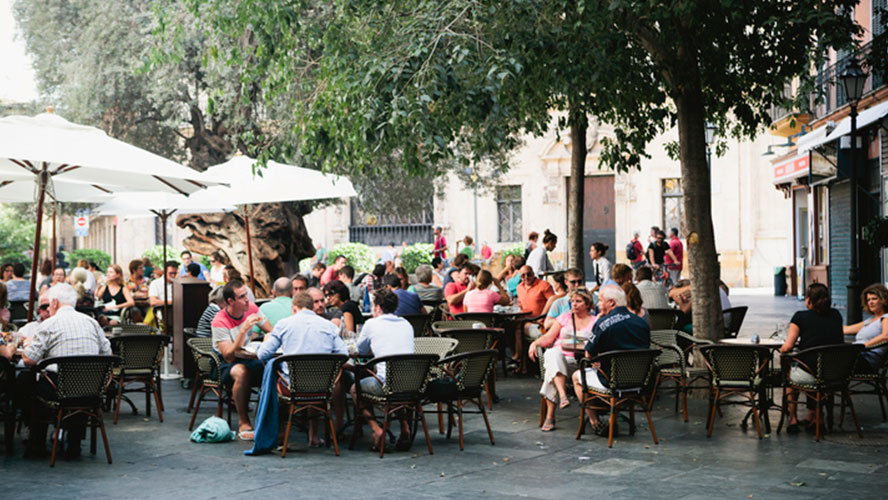
Callao
This is the focal point of one of the busiest shopping areas in the world. The Plaza del Callao connects the streets Preciados and Carmen with the century-old Gran Vía. It’s a very large and bustling space that serves as a meeting point for those who want to enjoy this little piece of the heart of Madrid. It’s estimated that 113 million people pass through this square every year. It has unique buildings such as the Carrión Building, the Palacio de la Prensa, the FNAC Building, and the Callao Cinema.
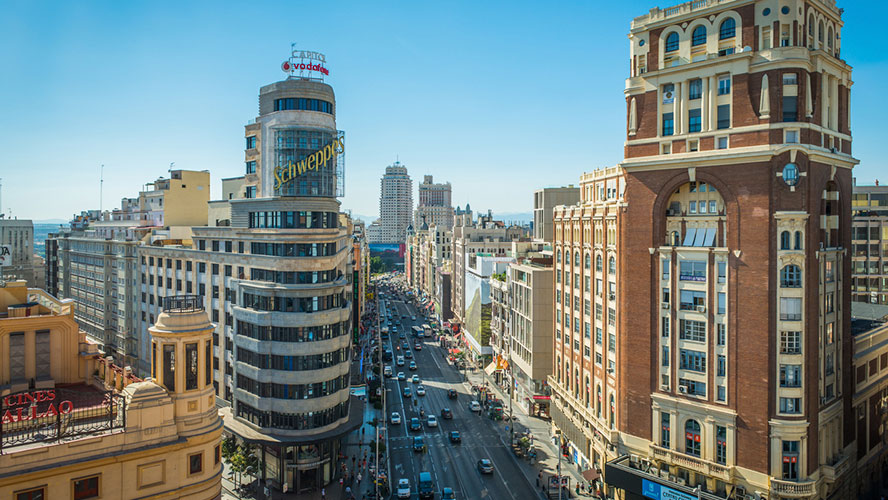
6. OTHER THINGS TO DO IN MADRID
Madrid offers 1,001 things to do. There are so many leisure options that it’s impossible to cover them all in a tourist guide. Even so, we invite you to enjoy the Warner Park, the Zoo, the Las Rozas Village shopping centre, the theatres and their musicals, the San Miguel Market, and trendy restaurants.
Warner Park
Warner Park is one of the major leisure attractions for children and adults alike. This theme park is located in San Martín de la Vega, on the outskirts of the capital, and is an ideal place for an outing with family or friends. It has the fourth-tallest drop tower in the world and 42 unique attractions, which are divided into five themed areas inspired by film and cartoon scenes, as well as by different areas of the United States. A4 road, exit 22. San Martín de la Vega
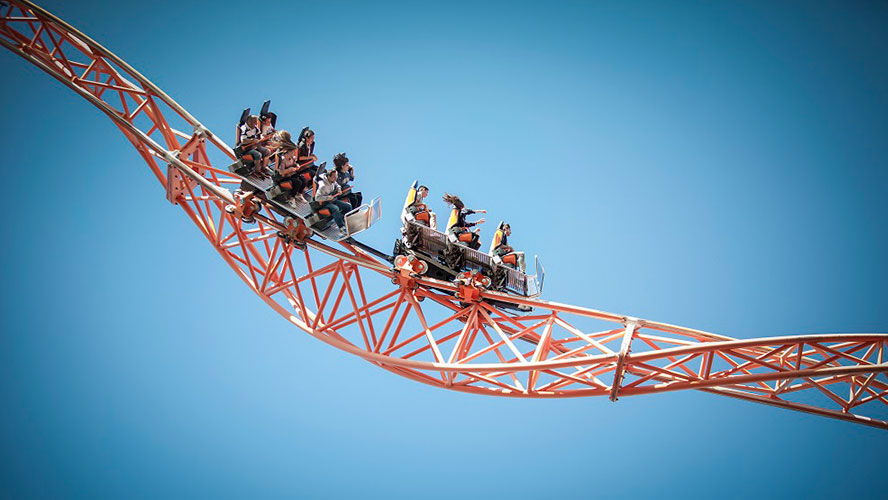
Zoo Aquarium
Located in Casa de Campo, the Madrid Zoo Aquarium is one of the ideal places to enjoy varied fauna in a relaxed way. It’s a large area of 22 hectares inhabited by some 4,000 animals of 500 different species from all over the world. There are lions, zebras, elephants, monkeys, giraffes, lemurs, dolphins, llamas, condors, as well as panda bears, possibly the most photographed animals in the Zoo Aquarium. Casa de Campo

Aquopolis
This is the largest water park in Madrid. It’s located in Villanueva de la Cañada and allows you to dream of an exotic destination thanks to its fun imagery inspired by Hawaiian surroundings, with gardens, canoes, waterfalls, palm trees, and, logically, a delightful beach, Malibu Beach, which measures over 2,200 square metres. It has golden sand, sun loungers, deckchairs, parasols and a kiosk where you can have a drink. And next to the beach, there’s a wave pool. Of course, there are plenty of rides that will have your adrenaline pumping, such as the Waikiki Jungle super-slide, and others that allow you to go aquaplaning or float down a tube in the dark. And for those who want to relax and rest, Aquopolis has private areas for sunbathing or eating in the shade. Here, the fun is guaranteed.
Las Rozas Village
This is the ideal place to spend a day shopping and enjoy top brands at affordable prices. Here you’ll find clothing, accessories, and decorative items from major international brands at up to 60% off the original price. There are over 100 boutiques in total. In other words, this is a real paradise for shopping lovers. A6 road, exit 19. Las Rozas

Theatre and musicals
Gran Vía is Madrid’s Broadway, because this urban street is where Madrid’s major theatres and successful musicals are located. So, if you like the performing arts, don’t waste any time and get a ticket for one of the many productions currently being staged. Don’t forget that, in addition to Gran Vía, there are theatres with very interesting shows all over the city. The theatre, moreover, is experiencing a new golden age.
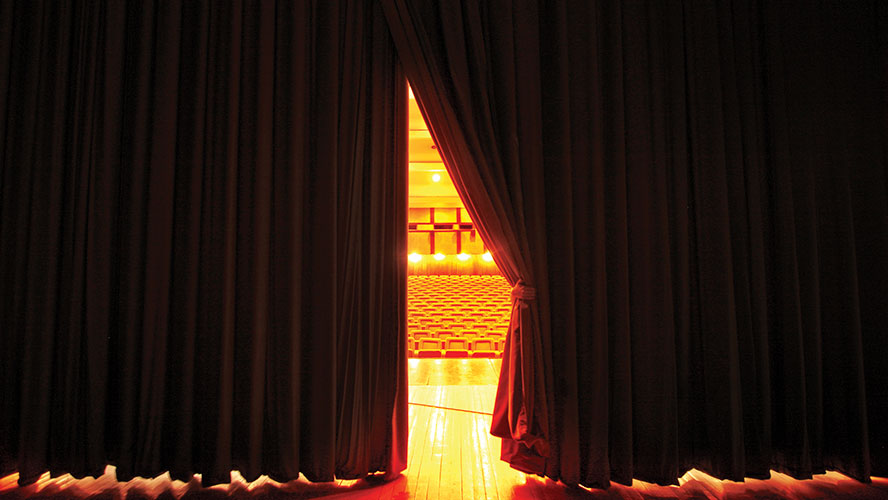
San Miguel Market
Located next to the Plaza Mayor, the delightful San Miguel Market is one of the great “monuments” to Spanish cuisine. With a history that goes back for centuries, this former local food market is now a gastronomic market that allows visitors to discover the typical food of Madrid and Spain: from Iberian ham to paella, as well as gourmet products and tapas from the most renowned Spanish chefs. It’s always packed. Plaza de San Miguel, no number
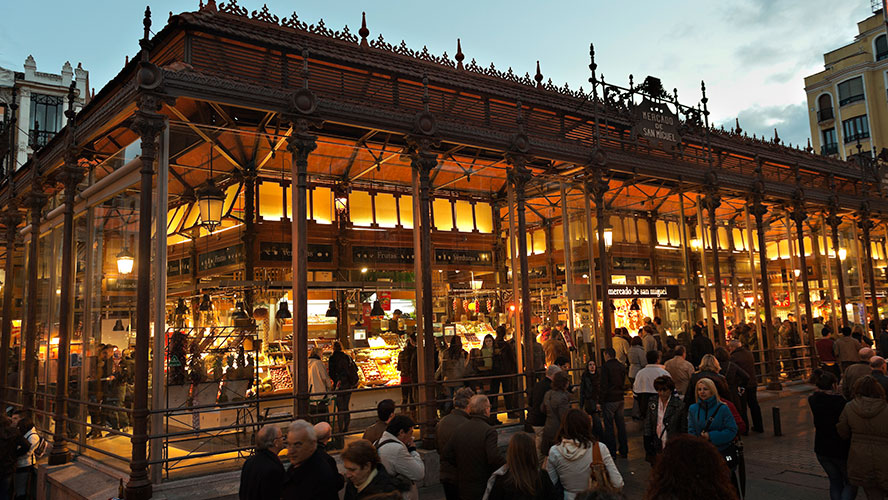
Trendy restaurants in Madrid
Madrid has become one of the world’s top gastronomic destinations, so you should make the most of your stay in the capital to enjoy its top-quality cuisine, which isn’t that expensive. There’s so much competition among the restaurants in Madrid and this means that menu prices are quite affordable. There are restaurants to suit all tastes and budgets, many of which offer daily set menus with several options to choose from. If you have the chance, discover a restaurant on one of Madrid’s rooftops. They’re very trendy and you can enjoy tasty mouthfuls with a good view.
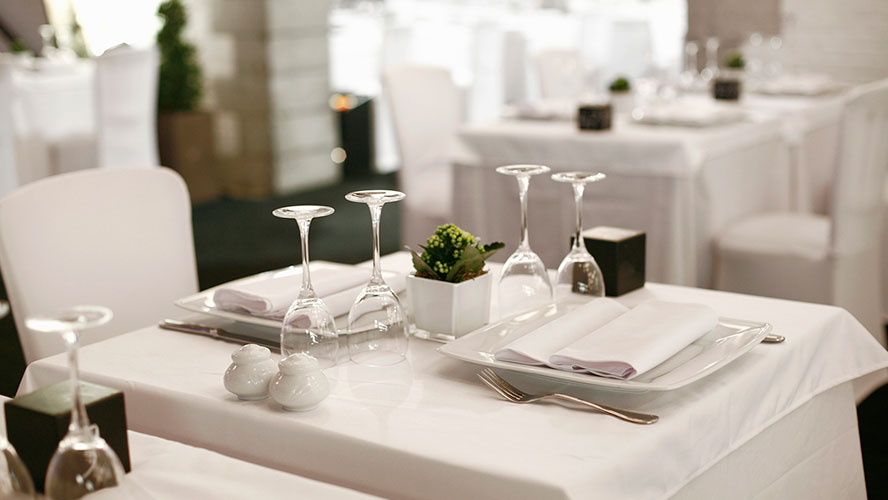
Public transport in Madrid
Madrid’s public transport is a world leader in terms of the quality and efficiency of its service. There are many options for getting around the city centre and the Community of Madrid. For example, there are around 215 urban bus lines (EMT), 12 metro lines, one light rail line, and 37 suburban railway stations. In addition, in the metropolitan area, there are more than 460 interurban bus lines, five metro lines, three light rail lines, and nine suburban railway lines. If you feel like pedalling, BiciMAD electric bicycles are the ideal choice for short trips around the centre of Madrid. You could also rent an electric scooter. There are over 15,000 taxis in Madrid and there’s also the option of taking the Madrid City Tour tourist bus, which stops at all the iconic points along its route: Historic Madrid and Modern Madrid.





























































